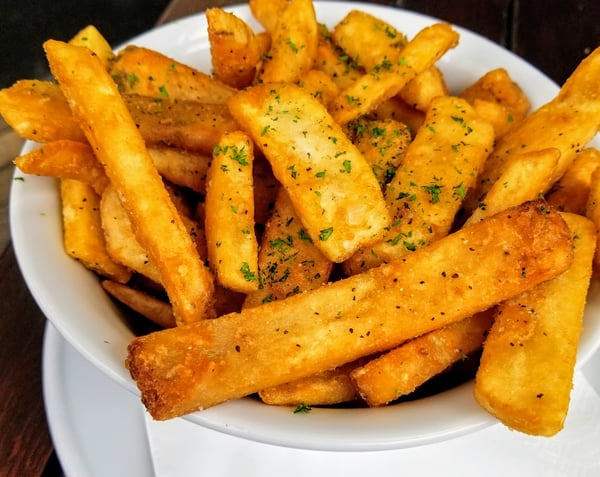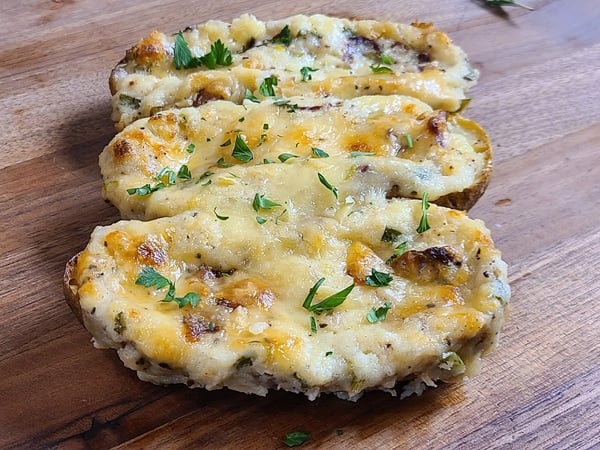The title of this blog isn't just a throwback to the 80’s, it's a deep dive into one of my favorite root vegetables: the potato. This tuber can be utilized in a multitude of different ways, which makes it a must-have pantry staple. Baked, fried, boiled, mashed, roasted, sautéed, scalloped, the list goes on and on to what you can turn a potato into.
Potatoes have gotten a bad rap for being an unhealthy choice but the truth is, potatoes are full of vitamins, minerals, antioxidants, and fiber which makes you feel fuller longer. No wonder they make such an excellent side dish in meals! The downside to potatoes are the amount of carbohydrates they contain and some preparations can make them an unhealthy choice. So, moderation is definitely the key to incorporating potatoes into your weeknight meals. We all love our deep-fried potatoes, but there are so many other ways to prepare them!

In our virtual Building Blocks series classes, we take an in-depth look at all of the fundamentals of cooking. We have done an egg, fish butchery, and pork class so far, and the next class this Saturday is all about potatoes and legumes. I am going to give you all a little sneak peek as to what we will be learning in this class. Have you ever had a less than desirable texture on your French fries or really weird finish to your mashed potatoes? Chances are the wrong potato was used for the job, and you never even knew it. Not all potatoes are created equal!
Potatoes usually fall under three different categories:
Starchy: These potatoes are high in starch and low in moisture. Baking potatoes have a dry, flaky texture, and fall apart when cooked (think of the middle of a fluffy baked potato.) This makes them great for baking and frying, but they don't hold their shape well, so they should be avoided in dishes like casseroles, gratins and potato salads. Examples would include russets and Idahos.

Waxy: These potatoes have a low starch content. Boiling potatoes have a thin skin, a waxy, smooth center and are often characterized by a creamy, firm, and moist flesh that holds its shape well after cooking. They're typically great for roasting, boiling, grilling, casseroles and potato salads. Some examples of waxy potatoes are red bliss, new potatoes or fingerlings.
All-Purpose: These potatoes have a medium starch content that fall somewhere in between the starchy and waxy potatoes. They're a true multi-purpose potato, and therefore can be used for just about any cooking application. A classic example is the Yukon Gold which can be cooked just about any way you can imagine.
You will want to choose potatoes by thinking about their purpose in the recipe. For instance, if the potato is being puréed to thicken a soup, choose a starchy baking potato. If the soup should have chunks of potato in it, a boiling potato is your best bet. The different cooking processes really do make a difference on the final outcome of the potato taste and texture. I want to give you some insight on this by doing a side-by-side comparison of how to make homemade tater tots cooking them in two different ways. Fun fact: did you know the name "tater tot" is a registered trademark of the American frozen food company Ore-Ida!? I had no idea. I thought it was just a generic term because tater is short for potato.
The Process
I started with two russet potatoes that I shredded on a box grater.
I squeezed out the starches of one potato through a cheese cloth, this would be the potato that that I would shape raw, not blanched.
I put the other shredded potato in a pot of cold water and brought it up to a boil. I let it cook for about 3 minutes until the pieces started to look a little opaque but still held their shape. It was important not to overcook at this stage. Alternatively, you can boil your whole potatoes until fork tender and then grate them after.
You can see in the next two pictures the visual differences between the raw potato and the cooked potato.
The raw potato (above) is much more dense and solid, the cooked potato (below) is fluffy and light.
For this comparison I am mainly focusing on the textures of cooked potato vs raw so I kept the seasonings the same for both tests.
I used potato starch as a binder but flour, tapioca, or cornstarch may also be used. I seasoned my tots with garlic, onion, paprika, salt, pepper, and dried thyme.
I shaped them into the traditional cylindrical tot shape. You can see the cooked potatoes on the left hold and shape better than the uncooked one on the right. This is mainly due to the starches coming out of the cooked potatoes mixing with the potato starch. Then the last step is to fry them at 365 degrees for about four minutes. Both versions took the same amount of time to get a crispy shell.
The complete recipe is below, and feel free to change out the seasonings based on preference. Fresh herbs can also be used instead of dried.
Homemade Tater Tots
Scroll down for a printable version of this recipe
Cook time: 5 minutes
Prep Time: 30 minutes
Makes: about 50 tots
2 pounds russet potatoes, peeled
1 tablespoon potato starch
1 teaspoon garlic powder
1/2 teaspoon onion powder
1/4 teaspoon dried thyme
1/4 teaspoon paprika
Kosher salt and freshly ground black pepper, to taste
1 cup vegetable oil
- Place potatoes in a large saucepan and cover with cold water by 1 inch. Bring to a boil and cook until parboiled, about 6-7 minutes; drain well and let cool.
- Using a box grater, finely shred potatoes. Using a clean dish towel or cheese cloth, drain potatoes completely, removing as much water as possible. Note: you can shred and then boil as well.
- Transfer potatoes to a large bowl. Stir in the starch, garlic powder, onion powder, paprika and thyme; season with salt and pepper, to taste. The mixture should be workable but dry.
- Form potatoes into tots.
- Heat vegetable oil in a large stockpot or Dutch oven over medium heat. The perfect frying temperature would be 365°.
- Fry the tots, 5 or 6 at a time, and cook until evenly golden and crispy, about 3-4 minutes. Transfer to a paper towel-lined plate.
- These tots may be frozen and fried from the freezer, just increase the cook time slightly.
So, what were the results of this side-by-side comparison?
The raw potatoes (above) held their shape and got golden brown and crispy, but the inside was hard and dense.
The boiled potato tots (above) were super crisp on the outside and light and flaky on the inside and their shape was more consistent. Just like that perfect French fry we have had in our lifetime; the boiled and fried method is really the best way to cook russet potatoes for a crisp exterior and a fluffy interior. It's the clear winner!
Hopefully, after reading this blog you feel more confident choosing the right potato for the right job and enjoy making homemade tater tots. This tot recipe can also be made using sweet potatoes following the same method of boiling and then frying them or even using cauliflower, if you are looking for a lower carb option. If you do not have the patience to shape and form all of your tots like I did you can also use a mini muffin tray to form them. If you freeze them in the tray they pop right out and into the fryer or you may bake the tots at 425° in the office. The cauliflower tots below were the same recipe as the potato tots just an even swap of vegetables! I baked them in the oven for a healthier alternative.
This virtual Building Blocks Series that The Chopping Block is offering takes place on Saturday mornings from 10am-Noon CST and goes through February 27th. Still to come are:
- Potatoes and Legumes Saturday, January 23 10am CST
- Mother Sauces (SOLD OUT)
- Soups Saturday, February 6 10am CST
- Chicken Butchery and Cookery Saturday, February 13 10am CST
- Beef Cookery Saturday, February 20 10am CST
- Vegetable and Rice Cookery Saturday, February 27 10am CST
These classes are designed to be a cook along style, where you are cooking in real time with the chef, but you may choose to participate in all of the recipes or just some of the recipes. Either way, you will still have all of your questions answered and feel confident recreating these recipes at your own convenience.
If you are looking for a more in-depth look at culinary subject matter, these are the classes for you, and I hope to see you in one soon!
If public cooking classes don’t fit into your schedule, our chefs are also available for private one on one cooking lessons that can be customized for you specifically and geared toward whatever you would like to learn in your own kitchen on your own time preference.
Homemade Tater Tots
Ingredients
- 2 pounds russet potatoes, peeled
- 1 tablespoon potato starch
- 1 teaspoon garlic powder
- 1/2 teaspoon onion powder
- 1/4 teaspoon dried thyme
- 1/4 teaspoon paprika
- Kosher salt and freshly ground black pepper, to taste
- 1 cup vegetable oil
Instructions
- Place potatoes in a large saucepan and cover with cold water by 1 inch. Bring to a boil and cook until parboiled, about 6-7 minutes; drain well and let cool.
- Using a box grater, finely shred potatoes. Using a clean dish towel or cheese cloth, drain potatoes completely, removing as much water as possible. Note: you can shred and then boil as well
- Transfer potatoes to a large bowl. Stir in the starch, garlic powder, onion powder, paprika and thyme; season with salt and pepper, to taste. The mixture should be workable but dry.
- Form potatoes into tots.
- Heat vegetable oil in a large stockpot or Dutch oven over medium heat. The perfect frying temperature would be 365°
- Fry the tots, 5 or 6 at a time, and cook until evenly golden and crispy, about 3-4 minutes. Transfer to a paper towel-lined plate.
- These tots may be frozen and fried from the freezer, just increase cook time.
